I like to think of myself as a rational, smart adult. But sometimes being a car person is at odds with that summation.
Here’s a good example.
About six months ago, I realized that my shop space was a mess. I was knee-deep in the last bits of my custom truck build, and I had parts and supplies spread out all over the place. Even taking time to clean up between individual projects wasn’t really enough to solve the problem. Storage was key. I had to put things away — but I didn’t have enough places to put those things.
Now, most normal, rational people would just jump on the web and order up a basic storage cabinet to solve this problem — or they’d spend money on a custom, modern solution. But, see, I’m a car guy who spent formative years as a mechanic in a small independent auto shop, surrounded by vintage shop cabinets. You know the type — metal cabinets that lock, and are usually supplied and branded by some parts company and are painted up in in bright colors. They’re intended to be filled with ignition parts or brake parts or the like.
Cabinets like these have both practicality and advertising flair, which I think makes them perfect for a small classic car garage — if you can find a vintage set in decent shape. So that’s what I set out to do.
I checked all the typical places, from Facebook Marketplace to Craigslist and beyond. I watched for old auto shops that might be closing. I peered into estate sales and garage sales as I passed by. I wandered around at the Portland Swap Meet. All I could find were various basic, dented-up generic metal cabinets in ho-hum gray. $10. $20. Free. You haul.
Days turned to weeks, weeks to months. With each search, those free solutions started to look better and better. I imagined stickering one of them up with some of my collected car decals so that it might blend in with my shop space.
And then, this past weekend, I found what I’d been looking for.
“Vintage Shop Cabinets,” is all the listing said. Images showed a free-standing set of two, clearly from the 1970s due to the woodgrain finish and vintage “Holley — OEM, Hi-Performance, Ignition, Carburetion” branding. They looked to be in good shape from the several images provided. Inside they had shelves and dividers, and outside there was little damage. Perfect.
Then I saw they were in The Dalles, which is about a two-hour drive from my place. One way. And the seller wanted $250. Not perfect.
Then I looked a little closer at the listing, which turned out to be a bad idea. “Originally from Radke’s in Portland,” it said.
Now I was hooked.
Speed Shop!
Radke’s was a legendary northwest speed shop. Founded in 1933, it evolved from a mom and pop-style service station into a local performance mecca. Big-name drag racers often went there to sign autographs. This is where most local muscle car and hot rod guys got their Cragars and Hurst shifters in the 1960s and 1970s.

Walking into the place felt like walking back in time. It was still kicking into the 2000s. Even in the midst of the mail-order revolution in aftermarket car parts, Radke’s held on — led by Merlin, the owner — by stocking the things that it would otherwise take a few days to get via the mail. When I needed something special, they always had it, from fluids to carburetor parts and beyond. The last thing I bought there was a lightweight, hollow fuel pump pushrod for a big-block Chevrolet. Summit was a week out. Radke had it that day.
The shop closed in 2015 and all the items inside were auctioned off. When Merlin died in 2017, he left the property to a local university, which later sold it. It still sits empty, but last I saw, it’s still painted up as it was when speed parts covered the walls.
So, this cabinet was part of all that? Good sense left my brain, along with any notion of a stickered-up plain cabinet.
I balanced the math in my head to see if reason could still win out: Getting there and back meant driving 200 miles total. That’s a half-tank of gas in my truck at almost $6 per gallon right now. Add another $250 (asking) for an old cabinet, and whatever my time is worth on a rare sunny weekend in October. Now we’re somewhere around $350 or more. Hmm.
Comparable plain cabinets are $10. Or free. This was dumb.
But other cabinets don’t have that awesome woodgrain finish, vintage Holley lettering or the local swagger of having come from Radke’s place. That’s worth something, right?
My attempt at reasoning evolved into justification. Math was losing the battle. I knew where this was going.
I appealed to the higher power in my household and explained the situation. She looked at me flatly, knowingly.
“When are you leaving?”
Early Bird
I called the seller and set up a time to meet on Sunday. Getting there meant leaving before the sun came up — but it hung directly in my face as I made my way up into the Columbia River Gorge and through Hood River on my way to The Dalles. The seller lived about seven blocks from the center of the old fur trade town, up on the side of the hill overlooking the area where the wagon trains of the Oregon Trail tried to float the rapids on the final leg of their journey. Fitting. I was now in bad idea country.
The seller probably sensed a sure sale in my willingness to drive the distance, as he’d already brought the cabinet outside and set it between his 1980s Ford F250 and a faded 1965 Chevy C10. We met and I looked it over. It was thicker gauge metal than I imagined.
“So how’d you get this out of Radke’s?” I asked.
“Well it’s a bit of a story,” he said. “You got a minute?”
I’d just driven two hours for an old metal cabinet. I obviously did. “Sure.”
“I’m a caretaker,” he said. “I was hired to take care of some land that included a house. A bunch of acreage. The place was packed full of stuff, like someone had just left one day and never came back. The people who hired me said the old man had died.
“It didn’t take long for me to realize the owners had once been the Radke family, what with all the mail and correspondence that I found around there. There was car stuff everywhere, including old catalogs and photos. I even found a shot of Don Prudhomme in front of the speed shop. Some of the stuff included family photos and the like. The sorts of things that people don’t tend to leave behind. I kept up with the place for a while before someone told me that Merlin was still alive.
“Anyway, a logging company had just come in to drop and clear out the big firs that surrounded the house, and I took some before and after pics, just because it looked so different with the trees gone. Now that I knew that Merlin was still around, I decided I needed to go see if he wanted any of the personal things that were out there. So I took those pics with me into town and went to the shop. This was about 2003. I went inside and met Merlin, had a nice chat, and then asked if he’d come outside for a second, away from the rest of the workers and customers.
“He was a shorter, round guy, and he sort of sauntered outside and hung his thumbs in his pockets. That’s when I handed over the pics of the house. He looked at them for an uncomfortable amount of time — especially long for someone you’ve just met — without saying a word. I told him what I was doing out there, and that I’d bring him whatever he wanted from the place. He thought for a minute and said, ‘There are some old family photos in there. I really wish I had them. That’s all I want.’
“So I gathered up all the paperwork, the photos and the like and brought them all to him. I think he appreciated that.
“He told me to keep whatever I wanted, and the current owners let me take a few things from the garage. The place was filled with this kind of stuff. Storage from door to door — so much that none of it could be useful. His storage solutions were a storage problem in themselves. I ended up with two sets of these cabinets.”
I looked the cabinets over again and sized up that story. Believable? Sure. Provable? Nope. Then again, most people wouldn’t care about an old speed shop, anyway — and it was a lot of work to dream all that up for those who might. Either way, here I was. I wasn’t going to float back to town empty.
So I paid the man $200 — too much money — and loaded the cabinets in my truck and headed for home. Two hours later, I had them standing up in my driveway.
“This is what you bought?” my wife asked as I dragged the blue and woodgrain steel across the smooth concrete and into place next to my welder. “Uh, they’re nice.”
Her tone dripped with sober reality. These cabinets looked right and were a good size, but this whole thing was pretty silly. The money spent suddenly seemed even larger. If I could get keys for the locks, I could store some of my more expensive equipment in them. But that meant even more money. What’s a locksmith cost these days?
I pulled out my phone and got to hunting to see what I could learn about the codes on the locks. After some digging, I came across something familiar: Two cabinets identical to the ones I had just bought, listed for sale. Asking price in both cases: $399, plus shipping. And both were only top cabinets, or 50% of what I just bought.
Sometimes luck is as good as rational, smart planning.
Either way, at least now I can clean up my garage.




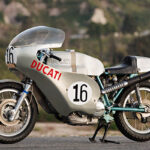
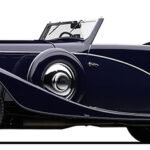
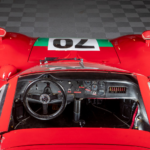

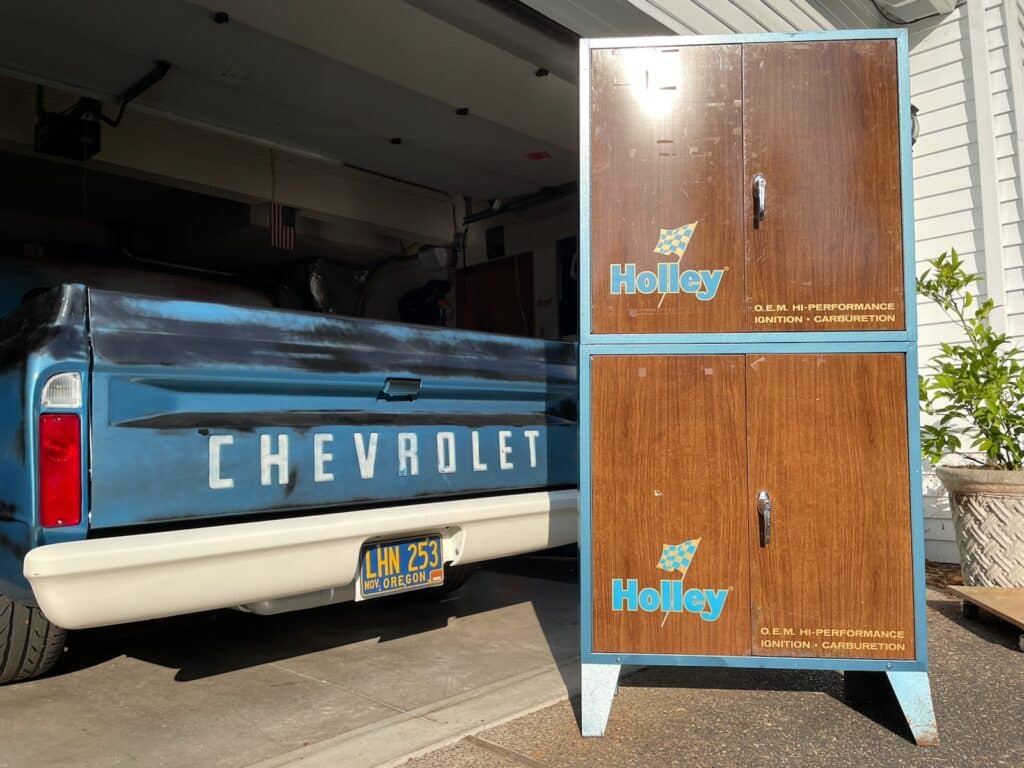

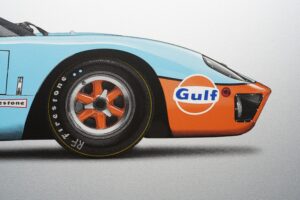
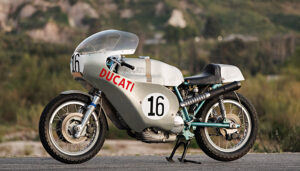
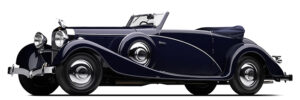
More Stories
The Future of Muscle
Finding GM Gold
Snapshots from Monterey